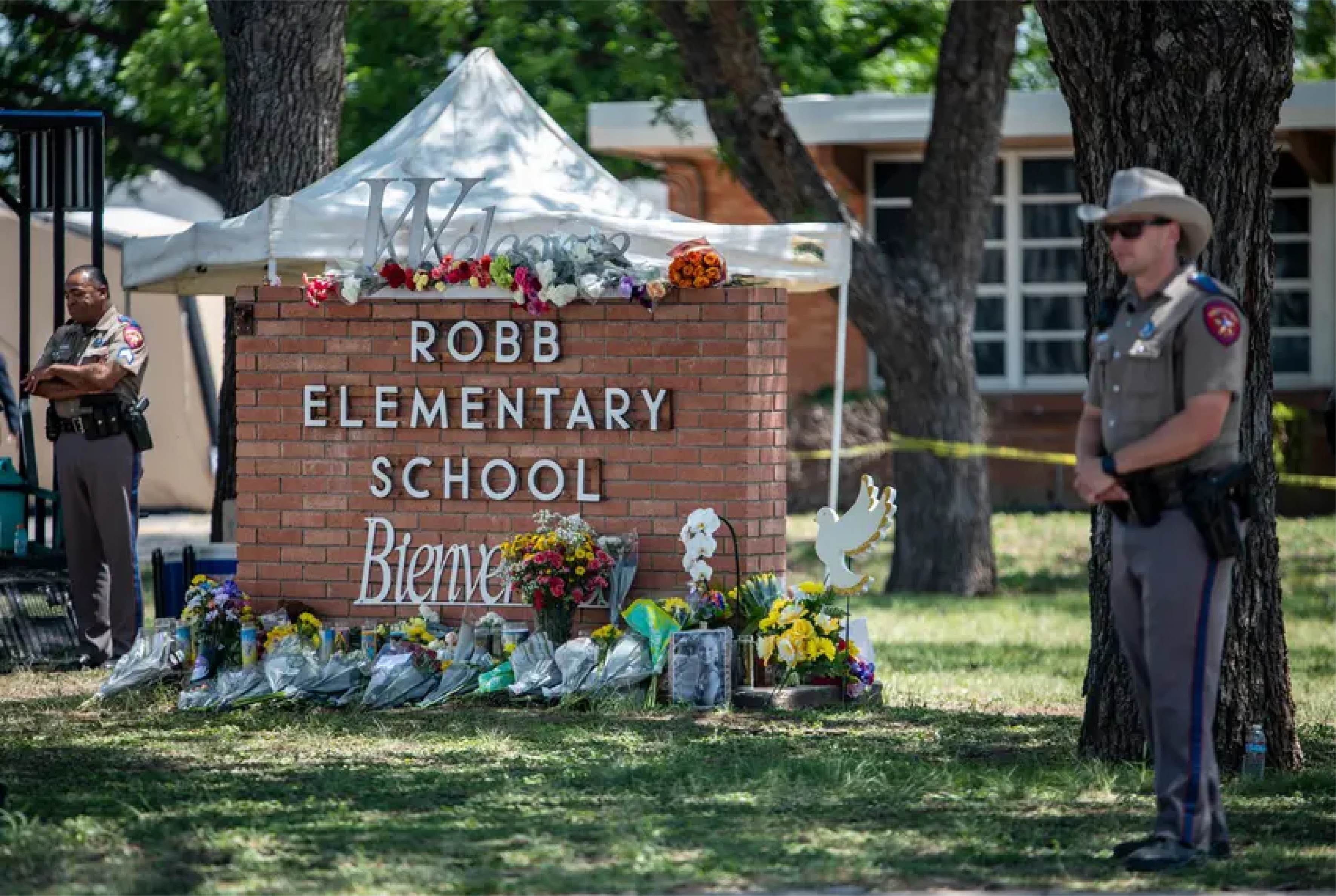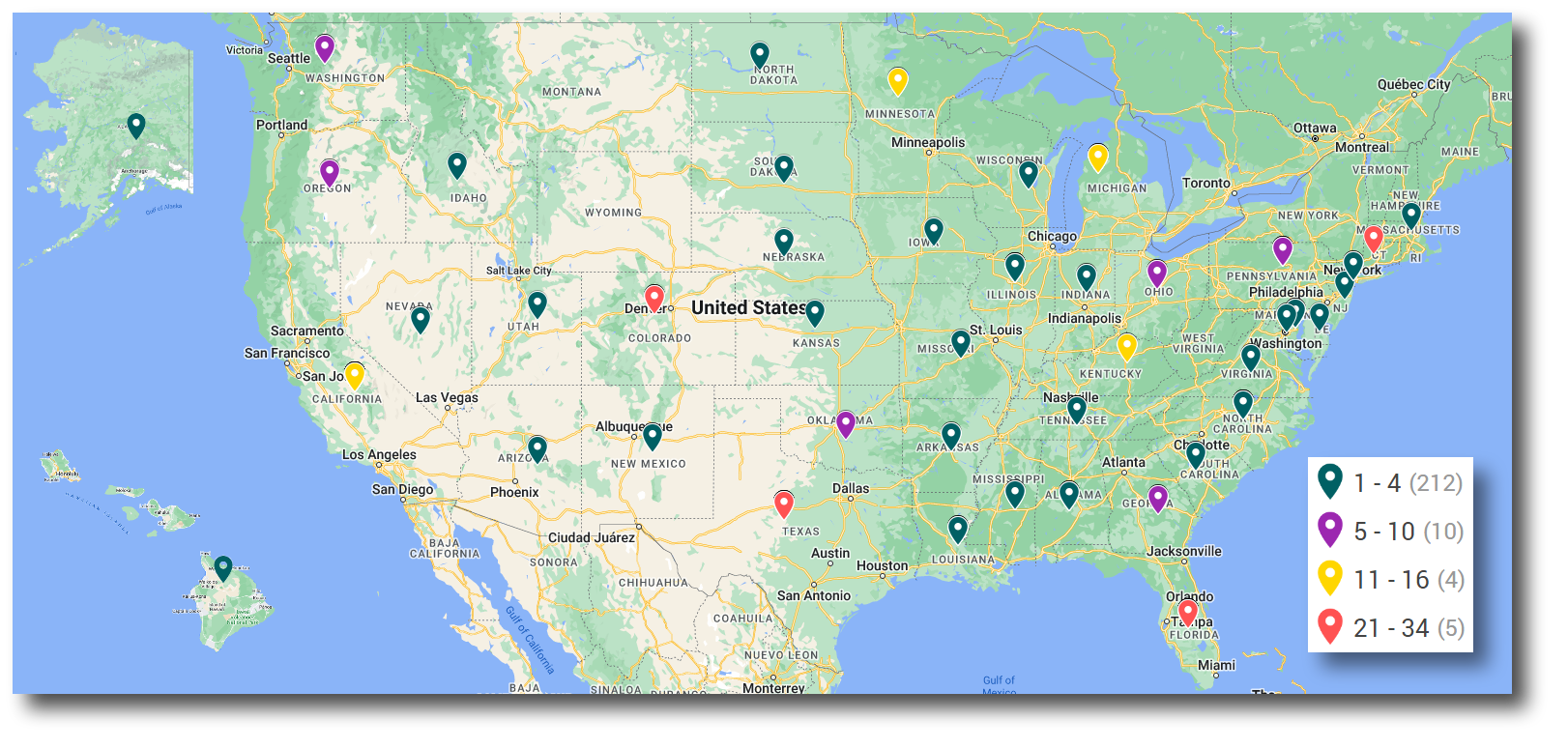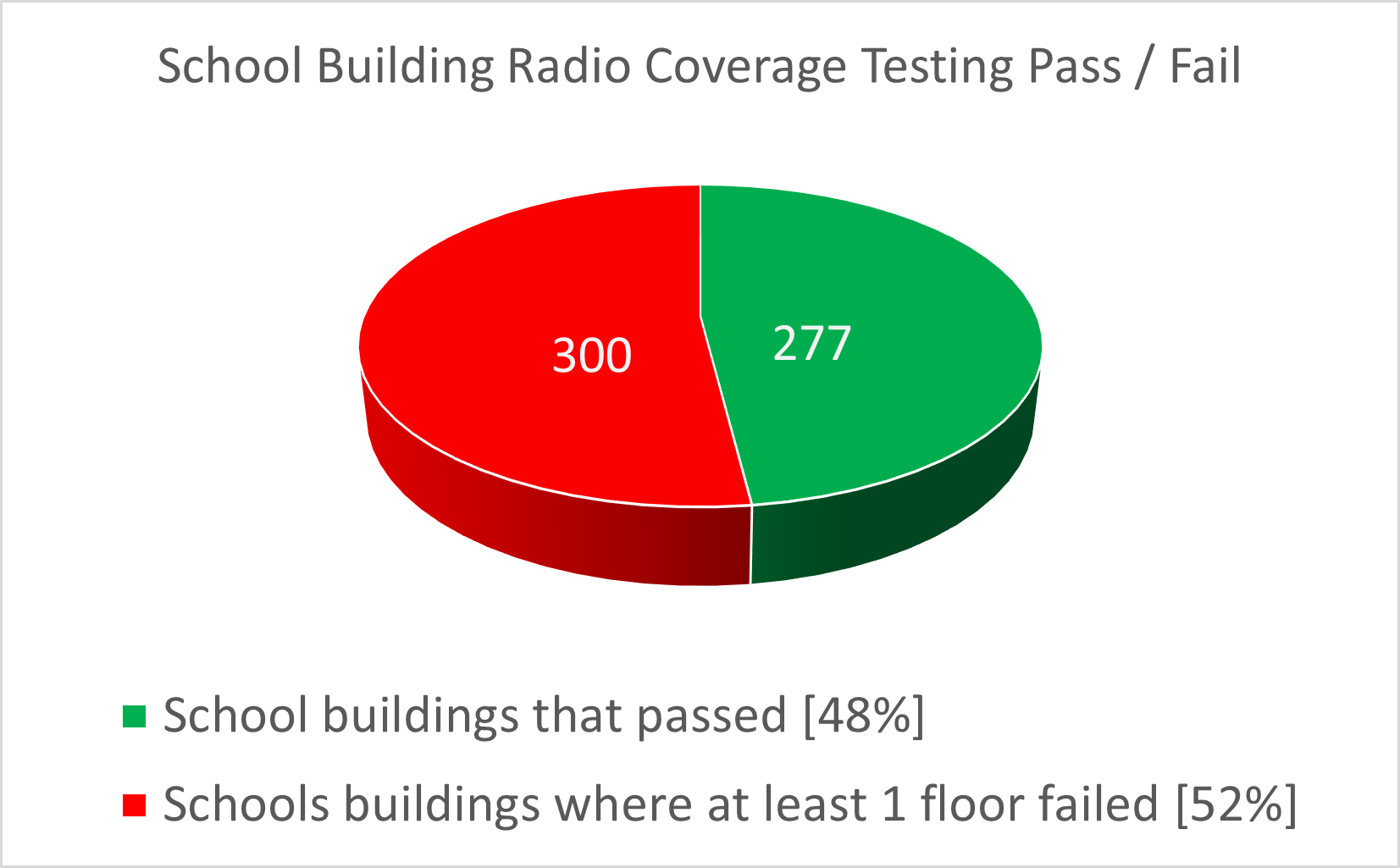Part II of II - Crisis in Plain Sight: In-Building Public Safety Radio Coverage in Schools

By John Foley, SBC Managing Director
Posted on November 3, 2022
We of the Safer Buildings Coalition mourn with the Uvalde community the tragic loss of life resulting from the assault on Robb Elementary School on May 25th and all mass-casualty events, especially in our schools. In Part I of this report, we cited after-action report information from the recent Uvalde, TX mass-shooting. Primarily, we examined a crucial element of this tragedy: Poor in-building public safety coverage.
We got quite a bit of feedback after that first article. Most of it (but not all) was supportive. Those with negative comments suggested that SBC, and the industry in general, were seeking to capitalize on tragedy for financial gain. There will always be some who never want to discuss uncomfortable topics, or who will suggest we should wait until the memory fades to address problems.
We would like to reiterate something we said in our first article:
While it is the role of many to find every solution that could make our schools safer, it is the role of the SBC to examine whether public safety communications may have been a factor in such an incident, and how we might work to improve such problems wherever possible.
We are not suggesting that solving for in-building communications will eliminate school shootings, or that there aren’t other, very serious challenges that must be addressed.
We are saying that our first responders and the children and faculty they protect should have every advantage available to minimize casualties and loss of life. Of the various strategies available to make our schools safer, solving for in-building wireless coverage is an advantage that is feasible and non-controversial. We can do this, so we must.
In Part II of this two-part series, we examine:
- How common is the problem? Actual school in-building testing data
- Success Stories
- Grants and Funding
- What other verticals need to be prioritized?
- Next Steps and Call to Action
The In-Building Communications Problem in Schools is Not New….
In preparing this report, we looked at the history of US school shootings going back to Columbine in 1999. The map below shows color-coded pins for each state, with the color representing the number of casualties. In all, since then there have been 555 casualties, including 185 fatalities. Almost no US state has been spared. It’s a national crisis.
 Image Source: Washington Post School Shootings Database Image Source: Washington Post School Shootings Database
We examined the after-action reports from some of these mass-casualty incidents. We were surprised to see that as far back as Columbine, recommendations called for improving in-building communications in schools.
Columbine Review Commission Excerpt1 [1999]:
[p.xi] Recommendations for Improved Communications for Critical Emergencies.
Because effective radio communications are indispensable to rapid deployment to meet critical incidents, school districts where local police and rescue agencies utilize digital bandwidths for communications should consider the installation of transmission repeaters in larger school buildings to facilitate communications from within those buildings to outside receivers.
[p.70-71] Therefore, because effective radio communications constitute a major component of rapid deployment, the Commission recommends that school districts where local police agencies broadcast on a bandwidth such as 800 MHz consider the installation of transmission repeaters in large schools and other public buildings. Until radio communications are improved to the point that digital communications from inside large structures can be transmitted effectively to outside receivers, transmission repeaters should be considered necessary safety equipment like fire alarms and sprinkler systems.
And more recently….
Reynolds High School [2014]2
[p.3] Operational Communications Areas for Improvement
- Use of unique unit monikers that can be input into the Computer Aided Dispatch, CAD system without necessitating the creation of additional calls.
- Radio and cellular phone reception.
- Process for development of Common Operating Picture, shared situational awareness.
- Ability of dispatchers to identify the nature of the call.
- Wireless data system coverage.
- Access to School’s secured wireless networks.
- Cache of communications supplies and auxiliary equipment.
- Communications between MCEM, the school district, and the responders on scene
[p.19] 3.3.2 Radio and cellular phone reception.
Analysis: The radio reception in the school buildings was poor because the building was not equipped with repeaters. Although TPD and the other response entities onsite used runners as a work-around for the poor radio communications, this alternative may not be possible in all situations. Some interviewees stated that their cell phones did not download voice messages until the evening, but that text messages were received immediately.
Recommendation: Consider equipping the school with repeaters so that radios work throughout the various school buildings as law enforcement and fire/emergency responders did not have cellular access as the reception was poor given the network overload, and they did not have phone chargers to charge phones once they had died. Also consider equipping response personnel (or the Mobile Command Vehicle) with USB battery pack phone chargers to allow for personnel to charge phones and be mobile during such incidents, instead of having to be near an electrical outlet.
Until radio communications are improved to the point that digital communications from inside large structures can be transmitted effectively to outside receivers, transmission repeaters should be considered necessary safety equipment like fire alarms and sprinkler systems.
Columbine Review Commission Excerpt1
How Common is the Problem? Let's Look at the Data...
We reached out to our SBC members for help and received a significant volume of in-building testing data.
The following data summarizes records where the property type was k-12 school:
Pass / Fail
577 - School buildings sampled (Most schools had more than one building)
277 – School buildings that passed [48%]
300 – Schools buildings where at least 1 floor failed [52%]
Test Type:
Signal Strength and DAQ: 573
Signal Strength Only: 4
Number of Building Stories:
1 story: 462
2 stories: 106
3 stories: 8
4 stories: 1

Conclusion: In-building wireless dead zones within k-12 schools is far from rare. In fact, with a >50% failure rate in our sample study, there is a strong indication that this is a crisis in plain sight.
Success Stories
One of the most interesting success stories comes from Knox County, TN, and the Knox County School District.
According to a knox news article dated Nov 13, 2019, entitled, “Nightmare' scenario: Police radios don't work at some schools”, when there were reports of gunfire at Powell High School in September, a frightening communications issue became clear. School resource officers charged with keeping the campus secure couldn't communicate effectively with their radios.3
While the report turned out to be unfounded, the revelation was sobering. As Knox County Commissioner Justin Biggs, stated: “I realized we have the possibility of a nightmare on our hands. ... I hope we never have a school shooting (or) something,” he said. “But 15 or 20 minutes in that world is a lifetime. You’re putting a dollar amount on how much our emergency staff and kids’ lives cost. It’s a scary situation.”
Rural Metro Fire spokesman Jeff Bagwell said it wouldn’t be uncommon for schools or hospitals to have trouble with radio frequency because they are built with concrete walls and steel roofs. You’re going to have problems with communication no matter what kind of radio you have, he said.
Success came when the commission voted on a nonbinding resolution that resulted in a RFP being issued as Bid Number 2934, Knox County Procurement Division. The scope of the bid was to obtain sealed bids for the provision of Public Safety Radio Benchmarking. Knox County Schools has ninety (90) Educational facilities across Knox County. Each site was surveyed for signal quality and strength on the 700/800 MHz Public Safety spectrum. The benchmarking site survey was based on the acceptance testing in Section 510.5.3 of the 2018 International Fire Code and be completed using an RF Spectrum Analyzer to generate “heat maps” showing signal coverage levels within the building.
Why was this a success?
It was a clear example of civic leadership by the Knox County Commissioners to be proactive in recognizing the threat of in-building wireless dead zones, and then taking action before an incident occurred. The testing RFP was secured by SBC member Teleco.
Due to competitive concerns, many SBC members were reluctant to share sales and project data regarding in-building public safety projects. However, we can state anecdotally that thousands of k-12 schools have been surveyed, and systems deployed.
Some other examples provided by some SBC members:
- Installed 50+ BDAs in all the local schools in my former jurisdiction. NC Department of Insurance
- Northville Public Schools ERCES Roll out. Diversified Wire and Cable
- We recently worked with a school district in Indiana to improve indoor cell coverage. Graybar
- Orange County, FL – A Large OEM has shipped hundreds of BDAs for K-12 school projects
- Installing BDAs in two new Plainview TX public schools. Project is not yet completed. Signal Compliance Corp
- In 2020 our company tested every school in the Cypress Fairbanks (CyFair) ISD (Harris County, TX). Working with the license holder (Harris County Radio Communications) 89 schools were tested with the PCTEL gear as well as DAQ testing with radios on the TxWarn P25 network. Less than 10% required mediation. The project which took less than 8 weeks gave the ISD a clear understanding of where every school stood as far as Emergency Radio Communications. This was invaluable to them. - Motive Infrastructure Solutions
Grants and Funding
There is no definitive list of public funding, it’s more of a needle in a haystack type search operation. Like all grant writing, it is up to the grant writing expert to craft a submission that makes the argument that the desired investment meets the criteria of the funding program. At this time, there do not appear to be any programs that explicitly say “funding for in-building public safety communications”. Writers must employ a “connect the dots” strategy.
Here are some funding sources that could conceivably make sense:
DHS Grants
DHS distributes approximately $1 billion dollars in homeland security preparedness grant funds each year. These funds support building, sustaining, and delivering core capabilities to prevent, protect against, mitigate, respond to, and recover from terrorist attacks and other hazards. DHS’ grant portfolio includes both broad risk-based grant programs aimed at enhancing preparedness of State and local jurisdictions, such as the State Homeland Security Program, Urban Area Security Initiative, and Securing the Cities Program, and more focused programs that target certain infrastructure that falls within the scope of ST-CPs, such as the Transit Security Grant Program, Intercity Bus Security Grant Program, Intercity Passenger Rail Grant Program, and Port Security Grant Program.
As part of distributing grant dollars, DHS requires recipients and subrecipients to provide details on their grant funding investments. From this reporting, DHS is able to discern positive impact on ST-CP security and preparedness. While not specific to ST-CPs, funding provided through grants is being used across the Nation to build core capabilities like interoperable communications, screening and detection, and risk management, which ultimately increases the baseline level of preparedness and resilience in and around soft targets.
DHS has identified six national priority areas in the FY 2022 grant cycle: cybersecurity; soft targets and crowded places; intelligence and information sharing; domestic violent extremism; community preparedness and resilience; and election security. Grant recipients under the State Homeland Security Program and Urban Area Security Initiative will be required to dedicate a minimum of 30% of their awards across these six priority areas.
ESSER
ESSER stands for the Elementary and Secondary School Emergency Relief Fund, a federal program administered by the Department of Education in response to the COVID-19 pandemic. The program provides emergency financial assistance to public school districts across the country.
The American Rescue Plan Elementary and Secondary School Emergency Relief (ARP ESSER) Fund under the American Rescue Plan (ARP) Act of 2021, Public Law 117-2, enacted on March 11, 2021. ARP ESSER provides a total of nearly $122 billion to States and school districts to help safely reopen and sustain the safe operation of schools and address the impact of the coronavirus pandemic on the nation’s students. In addition to ARP ESSER, the ARP Act includes $3 billion for special education, $850 million for the Outlying Areas, $2.75 billion to support non-public schools, and additional funding for homeless children and youth, Tribal educational agencies, Native Hawaiians, and Alaska Natives.
What can ESSER funds be used for? [Select examples]
- Investing in educational technology and remote learning tools, including hardware like headphones, software and connectivity to support student learning. SEA’s in all 50 states, Puerto Rico and the District of Columbia apply directly to the Department of Education for ESSER funds and are responsible for allocating the funds to relevant school districts.
- Other activities that are necessary to maintain operation of and continuity of and services, including continuing to employ existing or hiring new LEA and school staff
Example of ESSER Application:
Des Moines Register Article: June 14, 2022 4
Headline: Kim Reynolds announces $100 million to prevent school shootings in Iowa
Excerpts: Iowa will spend $100 million of federal funding to prevent school shootings, Gov. Kim Reynolds announced Tuesday. The funds will be used to conduct vulnerability assessments on schools, provide active shooter training, hire additional staff at the Department of Public Safety and create new pathways to report and monitor threats of violence. Schools, both public and private, will also be eligible for up to $50,000 each to improve the security of their buildings.
Reynolds emphasized that the state's approach to preventing school shootings would be "holistic," including mental health care, training for school staff and law enforcement, and infrastructure changes to school buildings.
The majority of the new money, more than $80 million, will be used to assess and improve the security of school buildings.
COPS Office School Violence Prevention Program
The 2022 COPS Office School Violence Prevention Program is a competitive program that provides funding directly to States, units of local government, Indian tribes, and their public agencies to be used to improve security at schools and on school grounds in the jurisdiction of the grantee through evidence-based school safety programs. Up to $53 million is available for this program.
Other Relevant Information
U.S. Senator Roger Marshall (R-Kan.) said on Wednesday, June 22, 2022, that support has grown for his and Congressman Mike Garcia’s (R-CA) Safe Schools Act, which would allow COVID-19 relief funds to be allocated to schools through the Elementary and Secondary School Emergency Relief Fund. The bill now has 18 Senate Cosponsors and has been endorsed by AG Schmidt, the Security Industry Association, and Kansas Rep. Kristey Williams (R-Augusta) and Sen. Renee Erickson (R-Wichita).
Secretary of Homeland Security Alejandro N. Mayorkas announced $1.6 billion for eight fiscal year 2022 preparedness grant programs. Together, these programs provide critical funding to help state and local officials prepare for, prevent, protect against and respond to acts of terrorism and other hazards. This funding is in addition to the $405.1 million announced last month for the Emergency Management Performance Grant Program.
[NOTE: All grants have application and funding windows. The examples above are intended to assist readers in what to look for. The actual examples may expire soon or may already have expired. New programs are being created every day, and communities must increase awareness and focus by federal, state, and local governments to prioritize school safety. Some of these examples came from a web resource provided by ASR Alert Systems: https://www.asralertsystems.com/school-safety-funding]
What Other Verticals Need to be Prioritized?
The US Department of Homeland Security issued a report in May 2018 entitled, “Soft Targets and Crowded Places Security Plan Overview”.
So, what is a “Soft Target”? An excerpt from the DHS report:
“Soft Targets and Crowded Places (ST-CPs), such as sports venues, shopping venues, schools, and transportation systems, are locations that are easily accessible to large numbers of people and that have limited security or protective measures in place making them vulnerable to attack.”
We would also add healthcare facilities to this list. There are four primary reasons for this.
First, wireless coverage facilitates access to telemedicine. Time counts in an emergency. Second, first responders are frequently found in hospitals, especially police and EMS. Third, hospitals are high-population facilities with vulnerable occupants. Fourth, hospitals frequently contain many areas that are difficult to penetrate with RF.
THIS DOES NOT MEAN that other buildings don't need coverage or should not be a priority. Commercial real estate, multi-family dwellings, industrial, storage facilities, distribution centers, data centers, and other building types all represent safety risks when wireless coverage is not present. We are merely recognizing a reality that with more than a million existing buildings in the US that likely need wireless coverage reinforcement, we must make a good start and set priorities. It is SBC's position that all new and existing buildings should be evaluated for code compliant public safety communications coverage, and where deficient, corrected.
SBC therefore proposes that policy makers elevate new and existing building “soft targets” for prioritized action:
- Schools
- Hospitals / Healthcare
- Shopping venues
- Malls
- Supermarkets
- Big Box Stores
- Sports Venues
- Transportation Systems
- Airports
- Subway systems
- Rail Stations
Next Steps and Call to Action
The US Government’s Final Report of the Federal Commission on School Safety5 recommended the following: DHS, in partnership with the U.S. Departments of Education and Justice, should explore legislative, regulatory, or procedural modifications to existing grant programs to enable more grant funding or related resources to be available for enhancing school security operations and physical infrastructure. As part of this, DHS should explore designating a portion of Homeland Security Grants for school security activities and premise the use of those funds on activities that accomplish enhancements recommended in DHS guidance or standards.
SBC could not agree more. SBC urges the following call to action:
SBC CALL TO ACTION:
- Raise Awareness of the threat of in-building wireless dead zones
- General Public
- Elected Officials
- Public Safety Agencies
- Advocate for enforcement of in-building public safety communications requirements in all applicable buildings
- Prioritize “soft targets” for enforcement, placing schools at the top of that list.
- Collaborate with federal, state, and local governments to create or identify grants and other public funding sources for in-building public safety communications
As always, the Safer Buildings Coalition will continue to strive to make buildings safer for first responders and the communities they protect. We welcome your help. Learn more about our mission and how to get involved here: www.saferbuildings.org
Footnotes:
1 Columbine report, found at: https://www.theiacp.org/after-action-review
2 Reynolds High School Report, found at: https://sbc.memberclicks.net/assets/docs/Reynolds_HS_AAR_10-4-16.pdf
3 knox news article, found at: https://www.knoxnews.com/story/news/local/2019/11/13/police-radios-do-not-work-at-some-knox-county-schools/2567117001/
4 Des Moines Register article, found at: https://www.desmoinesregister.com/story/news/politics/2022/06/14/iowa-gov-kim-reynolds-plan-training-against-school-shootings-ames-uvalde-response/7612815001/
5 Final Report of the Federal Commission on School Safety, p.126
Have a comment about this article? Send us your feedback or question...
Related Article: Part I of II - Crisis in Plain Sight: Robb Elementary Shooting Reveals that In-Building Public Safety Radio Coverage was "Mostly Ineffective"
Link(s) to other SBC School stories:
Video - A Case for Student Safety: Hear what school officials have to say about FirstNet’s role in their students’ safety
Senate Introduces the School Safety Clearinghouse Act
|



